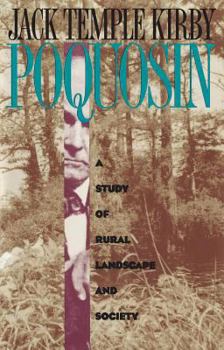Poquosin: A Study of Rural Landscape and Society
(Part of the Studies in Rural Culture Series)
Select Format
Select Condition 
Book Overview
Jack Temple Kirby charts the history of the low country between the James River in Virginia and Albemarle Sound in North Carolina. The Algonquian word for this country, which means 'swamp-on-a-hill, '... This description may be from another edition of this product.
Format:Hardcover
Language:English
ISBN:0807822140
ISBN13:9780807822142
Release Date:August 1995
Publisher:University of North Carolina Press
Length:320 Pages
Weight:1.60 lbs.
Dimensions:6.1" x 9.3"
Customer Reviews
1 rating
Out back of beyond
Published by Thriftbooks.com User , 17 years ago
I lived on the edge of the poquosin country for a decade, and it seemed so wild, so untouched, so empty that it couldn't have had a history. But of course it did, and Professor Jack Temple Kirby has written it in his expected elegant style. A poquosin is a slightly higher and drier patch in the soggy coastal plain of the American South, with its center in the Great Dismal Swamp of southeastern Virginia and northeastern North Carolina. It might have been logical that with an entire rich continent to expand into, the early white settlers would have passed by this unhealthy and difficult country. But that is not how people behave. Kirby divides the people into the cosmopolitans and the inhabitants, or as he calls them, the hinterlanders. The cosmopolitans lived on the fringes of the swamp, were educated and had capital and skills. They wished to employ these close to home. They financed canals, roads and railroads and hired the inhabitants or paid for the resources they could gather, primarily shingles, but also furs, turpentine, fish. The hinterlanders were marginal characters, especially the black slaves, getting by on canal digging, trapping, fishing, logging, turpentining and farming. Yet, ironically, they were also independent. For the slaves, especially, working on their own, away from their owners, being a "swamper" was a kind of freedom. Kirby also interprets these men and women as more or less conscious rejecters of consumer society. "Free workers used their wages to resist modernity." I don't think this is the correct reading. They consumed avidly when they had the money, which was seldom. That they did not abandon their hard, sickly life was probably because it is easier to be a poor man in the country than in the city. For a long time, cities had not much to offer the debilitated, illiterate, unskilled poquosin-man. Once that changed, the people escaped. For the blacks, with lower material expectations, this happened around 1916. Whites, slightly more demanding, did not flee until 1940. (See my review of Linda Flowers' "Throwed Away: Failures of Progress in Eastern North Carolina.") Left behind were the helpless and feckless. Kirby has not much to say about them, except to lament the "tragedy of a people unable to sustain themselves harmoniously on a rural landscape." Well, as Peter Huber wrote in "Hard Green" (see my review), the peasant squatting over a cow-dung fire is not green, he's just poor. The people of the area did sustain themselves harmoniously, they were just desperately poor. It isn't in Kirby's book, but in 1966, Sen. Bill Spong of Virginia made a hunger tour of the area and found whole communities -- almost all black women and children, the men were gone -- that sustained themselves on an annual two-months' worth of low-paid labor in vegetable canneries, plus whatever they could scratch out of their gardens. They were hungry, but they had not rejected modernity. Modernity had rejected them. As in Kirby's boo




